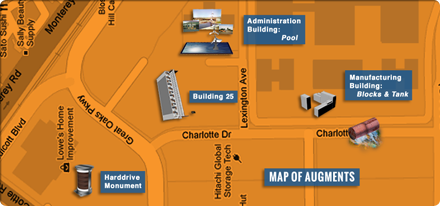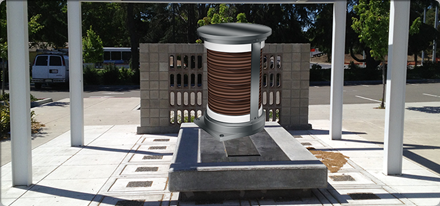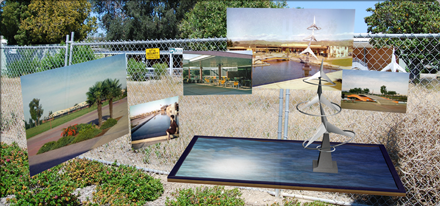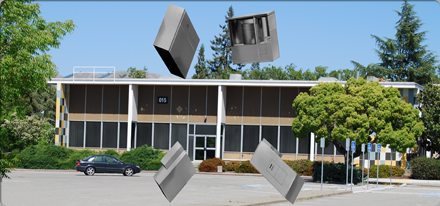Portfolio
All Works
Map of the Augments
This map indicates the locations of the augments. There are four locations relative to the Hard-Drive Exhibit in the Lowe's parking lot. The four locations are: Location 1 - Hard-Drive Monument; Location 2 - Building 25; Location 3 - The Reflecting Pool with Hydro-Gyro Sculpture; and Location 4 - The RAMAC Monument.
Learn MoreHow to Use the App
This video explains how the app works and how to interact with it. There are two modes for the app: an on-site mode that uses GPS to trigger events and appearance of objects, and a non-site mode that allows the user to interact with the story while not at the site.
Learn More
Location 1: The Hard-Drive Monument
This location is the introduction to the tour. The Hard-Drive augment is located in the historical exhibition in the parking lot of the Lowe's department store at 5500 Cottle Road San Jose. Here we meet the people who will tell their stories of working at IBM, fighting for environmental justice, and re-telling the history of this place. Four discs can slide from the Hard-Drive augment to hear storytellers start us on an historical journey. Each location along the tour has an introductory narrative that begins once the viewer enters the area of the augment. Other narratives play when the viewer interacts with the augment located at the particular site.
Learn MoreLocation 2: Building 25
Building 25 was where the computer first hard-drive was designed and tested. The drive was the storage memory for the RAMAC 305 computer. It held five megabytes of data and it took about a second to retrieve information. Building 25 was designed by Bay Area architect John Savage Bolles and was a model for the high-tech campus that is now common among large Silicon Valley companies. The building was declared an historical landmark in 2008, unfortunately, not soon after the building burned to the ground. The Lowe's store sits on the original site of the building and incorporated architectural elements of Building 25 into its design. Walk into Building 25 and hear the history of the building and view images of its past.
Learn MoreLocation 3: Reflecting Pool and Hydro-Gyro Monument
This location is the boarded up remains of the IBM Administration Building. Architect Bolles commissioned a number of original artworks for the campus. This building had a beautiful reflecting pool with a bridge. In the pool was a large water-kinetic sculpture entitled Hydrogyro by Bay Area artist Robert B. Howard. Around the pool you see historical photos of the original building and if you turn around you are surrounded by historical images of Silicon Valley. Spin the Hydrogyro sculpture and hear the stories of people who lived and worked in early Silicon Valley and how they came to work in the High-Tech industry. Look at the reflection in the pool.
Learn MoreLocation 3: Reflecting Pool and Barrels Monument
One of the leading agricultural areas in the world, Silicon Valley was once known as The Valley of Heart's Delight. The Valley employed thousands of workers in canning factories and orchards. Because of the proximity to universities, military, and other institutions high-tech companies began establishing themselves in Silicon Valley in the 1950's. The IBM campus here was built in 1957. Workers from the agricultural industry found manufacturing jobs in these high-tech companies. Over the next half a century Silicon Valley transformed itself from an agricultural center to one of the most important high-tech centers in the world. Each spin of the Hydrogyro sculpture plays the story of a worker in the high-tech industry.
Learn MoreLocation 4: RAMAC Monument: Disassembled
The IBM campus encompassed all aspects of design and production of computer technologies. This campus had a research and design, education, marketing, sales, administration and manufacturing facilities. Women were hired to work in the "fab-labs" and "clean-labs" where circuit boards and electronic devices were manufactured. Men were also hired to work on assembly lines, but more were hired or educated as engineers and management. Toxic chemicals were used in the production of electronic devices and workers who handled these chemicals were exposed to materials that potentially put their health at risk. A number developed illness related to their work with these chemicals. Touch the parts of the RAMAC computer and it will assemble itself. Once assembled you'll hear the stories of these workers.
Learn MoreLocation 4: RAMAC Monument: Assembled
This site presents to us many stories buried under layers of history. This tour is designed to peal away these layers to hear the personal stories of those who lived and were affected by this historical legacy. This location concludes Silicon Monuments: an Augmented Reality Tour of Silicon Valley Superfund Sites.
Learn More







